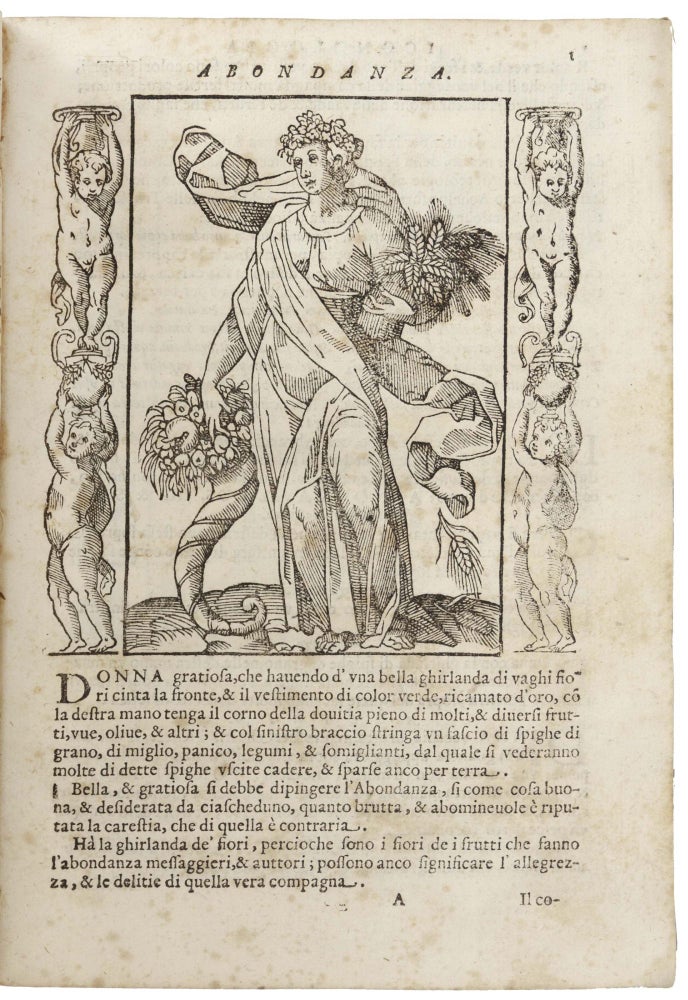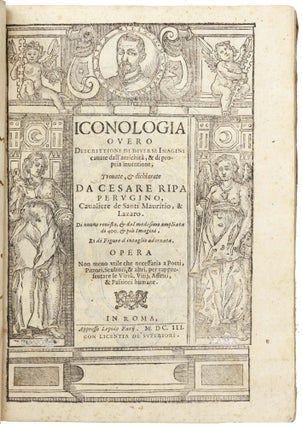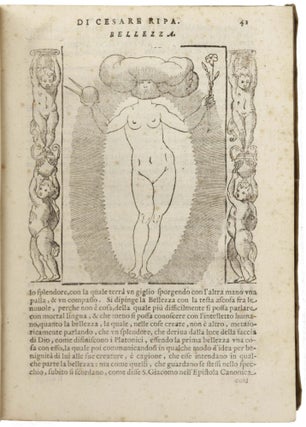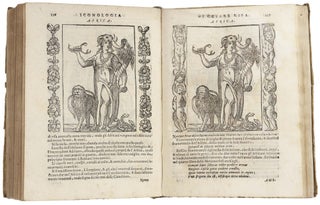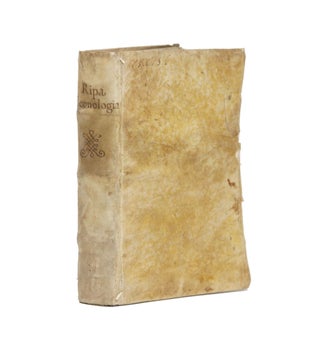Iconologia.
4to in eights [21.5 x 15.9 cm], (12) ff., 523 pp. [i.e. 519 pp.: pagination skips in quire H], (1) p., (2) ff, with woodcut border to title page (including author portrait), a full-page woodcut coat of arms, (151) woodcuts of personifications in the text, woodcut headpieces, tailpieces and inscriptions. Bound in contemporary vellum, title in manuscript on spine and on lower edge, remnants of ties, manuscript shelf mark on upper cover; binding slightly pulling away from spine and with a bit of chipping to fore edge of upper cover; slight tear to spine; paper flaw repair on g8. A few contemporary annotations correcting pagination errors, some light browning in some quires as typical of this title but much less than usual, minor marginal worm track in final leaves. General good, genuine. Rare first illustrated edition (1603) of Cesare Ripa’s (c. 1560-c. 1622) emblem book. A landmark compendium of allegorical personifications, his Iconologia, is a summa of ancient, medieval and early modern information on such images and a sourcebook of unparalleled richness which continues to guide artists and scholars more than four centuries after its publication. The unillustrated first edition (1593) included several hundred entries arranged alphabetically, but the present 1603 edition expanded these by more than half, describing 684 personifications and illustrating 151 of these with large woodcuts. New in this edition, for example, is a discussion of the ‘Four Continents,’ including the famous depiction of ‘America’ – a female native with a feather headdress, bow and arrow, and with an alligator and severed head at her feet – which would codify the personification of the New World for book illustrators, cartographers, printmakers and painters for years to come. “As a handbook for dilettantes, artists, literati, the imagini of the Iconologia eventually appeared in countless other contexts. Individual personifications were disseminated shortly after the publication of the second edition. By the middle of the seventeenth century, translations of the text had appeared in many European languages and spurred the multiplication and dissemination of the Iconologia. It appeared in the New World and became an indispensable book for artists” (Logemann, p. 32). The Iconologia was “the most influential handbook of symbolic imagery of the early modern period. It is an astonishing feat that Ripa, then the meat carver and butler in the household of Cardinal Anton Maria Salviati in Rome, compiled the work in his ‘leisure time’. Organized alphabetically as a lexicon of concepts visualized as personifications, Ripa’s handbook codified the most striking, easily understood of the attributes and interpretations proposed over the previous century and, in turn, provided an immensely popular, predigested model in the vernacular for a wider range of users for over two centuries, available in multiple editions and languages” (Spicer, pp. 677 and 679) In the course of the 16th century, emblem books and other illustrated series proliferated, giving rise to the need for a standardization or an authoritative overview of how to depict virtues, vices, months, geographical regions, and other such abstract concepts. Ripa’s book accomplished this and thus can be seen as “the culmination in the history of personifications in Western Christendom … The Iconologia fundamentally transformed the use and interpretation of personifications, including the contemporary understanding of personifications from before 1593 (or 1603). In art history, the rediscovery of the Iconologia in the early twentieth century also changed the attitude toward medieval allegorical personification. The book came to be regarded as a pivotal work for understanding allegorical images of the past” (Logemann, pp. 33-4). * Landwehr, French, Italian, Spanish, and Portuguese emblem books, 622; Praz, 472; C. Logemann, “Ripa, the Trinciante,” in C. Hourihane, ed., The Routledge Companion to Medieval Iconography, pp. 32-46; J. Spicer, “The Personification of Africa with an Elephant-head Crest in Cesare Ripas Iconologia (1603)” in Personification: Embodying Meaning and Emotion, W. Melion and B. Ramakers, eds., pp. 677-715; G. Werner, Ripa’s ‘Iconologia’. Quellen, Methode, Ziele; S. Maffei, Le radici antiche dei simboli. Studi sull’ “Iconologia” de Cesare Ripa e i suoi rapporti con l’antico; M. Callegari, “Cesare Ripa, his Iconologia and the Numismatic,” in C. Deksel and T. Stäcker, eds., Europäische numismatische Literatur im 17. Jahrhundert, pp. 101-07; G. Cherchi, “Tra animato e inanimate: Gli animali in Cesare Ripa,” in M. Gabriele, C. Galassi, and R. Guerini, eds., L’Icononologia de Cesare Ripa. Fonti letterarie e figurative dall’Antichita al Rinascimento, pp. 83-96; S. Pierguidi, “Giovanni Guerra and the Illustrations to Ripa’s Iconologia,” Journal of the Warburg and Courtauld Institutes, vol. 61 (1998), pp. 158-175.
Sold

